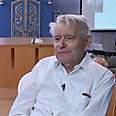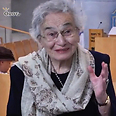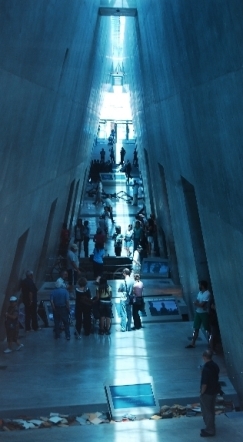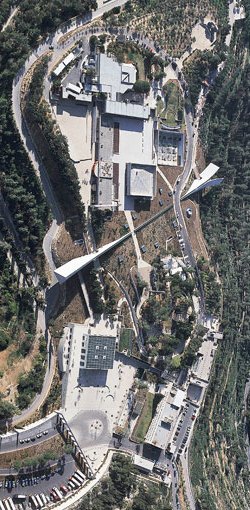
Zionism

Documented 350 Shuls in 70 weeks
FROM: YNETNEWS.com
User Sara from Seattle submitted this story she had seen on YNETnews.com and found very interesting. Remember that you can always send your own stories or links to things you find interesting, videos, stories (serious or interesting) to: online.editor@sajr.co.za for consideration.
350 synagogues in 70 weeks
Rivka and Ben-Zion Dorfman, both more than 90 years old, dedicated 70 weeks of their life to photograph and document more than 350 synagogues in Europe that were deserted after the Holocaust.
 The couple handed their life’s work over to the Yad Vashem Archives, where staff will continue tracing the lost communities through the ruined synagogues.
The couple handed their life’s work over to the Yad Vashem Archives, where staff will continue tracing the lost communities through the ruined synagogues.
“It began in 1987,” says Rivka Dorfman. “We went on a three-week vacation in Italy and saw a synagogue which really caught our imagination. It was the first, and after that we searched for other synagogues.”
 Dr. Ben-Zion Dorfman says that everywhere they arrived, they looked for people with gray hair and asked, “Where is the synagogue?”
Dr. Ben-Zion Dorfman says that everywhere they arrived, they looked for people with gray hair and asked, “Where is the synagogue?”
LEFT TOP: Dr. Ben-Zion Dorfman
LEFT BELOW: Rivka Dorfman
“I think we collected information about most if not all synagogues left from the World War II era,” he says. “What was left – we researched.
 “In every synagogue we were resourceful. We looked for all kinds of shapes of buildings. They usually knew and agreed to show us the local synagogue, or direct us to it.
“In every synagogue we were resourceful. We looked for all kinds of shapes of buildings. They usually knew and agreed to show us the local synagogue, or direct us to it.
“Sometimes the synagogue was locked and we had to look for someone to give us the keys. We visited offices of mayors who helped in many places. We informed them in advance that we were on our way, and when we arrived we were welcomed respectfully quite a few times.”
Peeling paint and no roof
The couple had a letter from the Hebrew University stating that they were operating for research purposes, which they say opened many doors for them – the doors of the deserted synagogues. Behind them they mostly found ceilings with peeling paint and signs of neglect that failed to diminish the uniqueness of the places.
 “We took pictures of the synagogues. There were many buildings that had changed. We didn’t focus on synagogues in the big capital cities, as those are well-known. We wanted to discover the ones in the towns. And more than once we found ruined places with no roof.”
“We took pictures of the synagogues. There were many buildings that had changed. We didn’t focus on synagogues in the big capital cities, as those are well-known. We wanted to discover the ones in the towns. And more than once we found ruined places with no roof.”
RIGHT: Inside Yad vashem
BELOW: The Yad Vashem Centre
The Dorfmans were faced with an artistic and architectural mission. “We documented a synagogue from 1859 in western Hungary designed in the shape of a circle. The building was deserted and damaged by vandalism, but wonderful paintings remained on the dome, and after we took the pictures we figured out the captions in Hebrew.
“We saw it for the first time in 1989 and have been there two more occasions since, and each time we saw a further deterioration in its condition. Now they are talking about possible restoration plans.”
Making museums from ruins
The active involvement and concern shown by the Dorfmans for the abandoned synagogues, completely voluntarily, led several times to the posting of a sign noting that a synagogue used to stand in this place.
 “In the Czech town of Rychnov we arranged a meeting at the mayor’s office in the afternoon. We arrived half an hour late, and found the deputy mayor standing in front of the city hall under an umbrella, waiting for us.
“In the Czech town of Rychnov we arranged a meeting at the mayor’s office in the afternoon. We arrived half an hour late, and found the deputy mayor standing in front of the city hall under an umbrella, waiting for us.
“He told us to get the interpreter. We went to the synagogue and discovered that it was being used as a warehouse for plumbing equipment. We weren’t surprised, because synagogues were used in different ways. We arrived half a century after the Holocaust, so there was time to turn them into warehouses. We wrote down everything we found, and tried to figure out what had been there before.
“The deputy mayor entered with us and was alarmed. He apologized for what had been done to the place; it’s a holy site for Jews. He promised that he would try to see what could be done.
“Over the years he convinced the people in charge to repair the synagogue, and we got pictures from him of the renovation’s progress. In one place they took off the plaster and found half a caption in Hebrew, and we completed the caption and the painting.
“When we returned to the town several years later, we found an amazing place. The synagogue building had been turned into a regional Jewish museum, and outside the building they added a monument to the victims of the Holocaust.
“Every year, on the day of the liberation of Auschwitz, the mayor and his deputy arrive and document the ceremony in memory of the local Jews who died in the Holocaust, and send us the pictures.”
The Dorfman couple, who immigrated to Israel from the United States, worked as researchers and teachers in the country. How can a couple without much wealth manage to sustain such work?
“We protected ourselves economically,” they say. “We tried to stay in people’s homes rather than at hotels, and that reduced our expenses significantly.”
The journey led to a book, “Synagogues without Jews,” and as well as lectures delivered by the two. Now, when they are in their 90s, Rivka and Ben-Zion have decided that there is no more room for the collection under their bed.
“There are pictures, videos, audio and many documents about every city and town we studied. We have rooms filled with stuff. It’s good to be free of all of this,” they say, smiling.
“Over the last decade we debated which institution should get the collection, and eventually decided that it would be Yad Vashem.”




